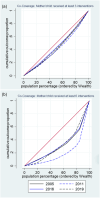Co-coverage of reproductive, maternal, newborn and child health interventions shows wide inequalities and is associated with child nutritional outcomes in Ethiopia (2005-2019)
- PMID: 36319604
- PMCID: PMC11258776
- DOI: 10.1111/mcn.13452
Co-coverage of reproductive, maternal, newborn and child health interventions shows wide inequalities and is associated with child nutritional outcomes in Ethiopia (2005-2019)
Abstract
The health system is the primary vehicle for the delivery of nutrition-specific interventions that aim to reduce maternal and child malnutrition. The integration of nutrition interventions into existing health interventions is promising, but to ensure that no one is left behind requires that access to essential health services is equitably distributed. This study aims to assess trends and socioeconomic inequalities in coverage of reproductive, maternal, newborn and child health (RMNCH) and assess its association with child nutritional outcomes in Ethiopia. Using the Ethiopian Demographic and Health Survey (2005, 2011, 2016, and 2019), we estimated the coverage of RMNCH interventions in Ethiopia using the co-coverage index, which is a count of the number of interventions accessed. We assessed the trend and inequalities in co-coverage and evaluated its association with child nutritional outcomes like stunting, wasting, and minimum dietary diversity (MDD). The national co-coverage index has shown a significant increase over the 2005-2019 period. However, all of the RMNCH interventions constituting the co-coverage index showed a pro-rich and pro-urban distribution (p < 0.05). The highest inequality, based on the slope index of inequality (SII), was observed for skilled assistance during delivery (SII: 80.4%), followed by access to an improved source of drinking water (SII: 62.6%), and antenatal care visits (SII: 55.5%). The low coverage in RMNCH and the observed inequality were associated with stunting, wasting, and MDD. Reducing socioeconomic inequality in RMNCH is key to achieve the health, nutrition and equity-related goals of the Sustainable Development Goals.
Keywords: child nutrition; diet; health system; maternal nutrition; nutrition‐specific interventions; stunting; wasting.
© 2022 The Authors. Maternal & Child Nutrition published by John Wiley & Sons Ltd.
Figures


References
-
- Alam, N. , Mamun, M. , & Dema, P. (2020). Reproductive, maternal, newborn, child, and adolescent health (RMNCAH): Key global public health agenda in SDG era, Good health and well‐being (pp. 583–593). Springer.
-
- Barros, A. J. , Ronsmans, C. , Axelson, H. , Loaiza, E. , Bertoldi, A. D. , França, G. V. , Bryce, J. , Boerma, J. T. , & Victora, C. G. (2012). Equity in maternal, newborn, and child health interventions in countdown to 2015: A retrospective review of survey data from 54 countries. The Lancet, 379(9822), 1225–1233. - PubMed
-
- Baye, K. (2021). Improved diet quality, a missing ingredient for accelerating stunting reduction: An example from Ethiopia. Archives of Disease in Childhood, 107, 5–6. - PubMed
-
- Baye, K. , & Hirvonen, K. (2020). Accelerating progress in improving diets and nutrition in Ethiopia, ESSP working papers 144. International Food Policy Research Institute (IFPRI).
MeSH terms
Grants and funding
LinkOut - more resources
Full Text Sources

